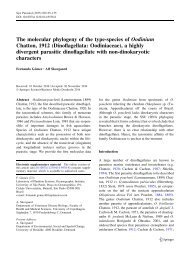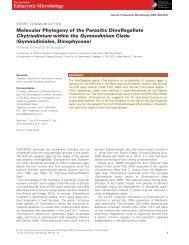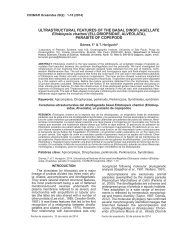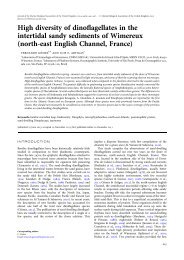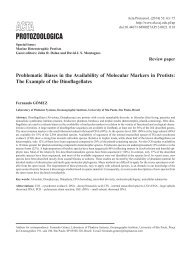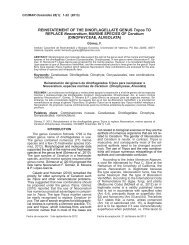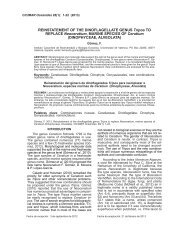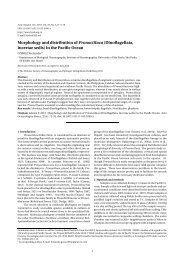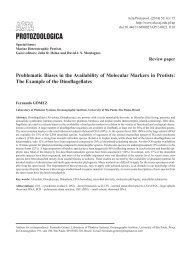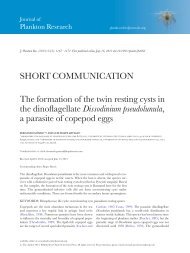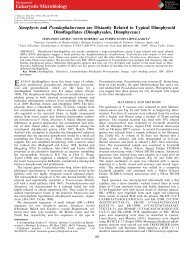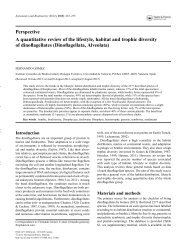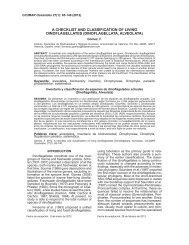Solenicola setigera is the first characterized memberof the abundant and cosmopolitan uncultured marine stramenopile group MAST-3
Culture-independent molecular methods based on the amplification, cloning and sequencing of smallsubunit (SSU) rRNA genes are a powerful tool to study the diversity of prokaryotic and eukaryotic microorganisms for which morphological features are not conspicuous. In recent years, molecular data from environmental surveys have revealed several clades of protists lacking cultured and/or described members. Among them are various clades of marine stramenopiles (heterokonts), which are thought to play an essential ecological role as grazers, being abundant and distributed in oceans worldwide. In this work, we show that Solenicola setigera, a distinctive widespread colonial marine protist, is a member of the environmental clade MArine STramenopile 3 (MAST-3). Solenicola is generally considered as a parasite or an epiphyte of the diatom Leptocylindrus mediterraneus. So far, the ultrastructural, morphological and ecological data available were insufficient to elucidate its phylogenetic position, even at the division or class level. We determined SSU rRNA gene sequences of S. setigera specimens sampled from different locations and seasons in the type locality, the Gulf of Lions, France. They were closely related, though not identical, which, together with morphological differences under electron microscopy, suggest the occurrence of several species. Solenicola sequences were well nested within the MAST-3 clade in phylogenetic trees. Since Solenicola is the first identified member of this abundant marine clade, we propose the name Solenicolida for the MAST-3 phylogenetic group.
Culture-independent molecular methods based on
the amplification, cloning and sequencing of smallsubunit
(SSU) rRNA genes are a powerful tool to
study the diversity of prokaryotic and eukaryotic
microorganisms for which morphological features are
not conspicuous. In recent years, molecular data from
environmental surveys have revealed several clades
of protists lacking cultured and/or described
members. Among them are various clades of marine
stramenopiles (heterokonts), which are thought to
play an essential ecological role as grazers, being
abundant and distributed in oceans worldwide. In this
work, we show that Solenicola setigera, a distinctive
widespread colonial marine protist, is a member of
the environmental clade MArine STramenopile 3
(MAST-3). Solenicola is generally considered as a
parasite or an epiphyte of the diatom Leptocylindrus
mediterraneus. So far, the ultrastructural, morphological
and ecological data available were insufficient
to elucidate its phylogenetic position, even at the division
or class level. We determined SSU rRNA gene
sequences of S. setigera specimens sampled from
different locations and seasons in the type locality,
the Gulf of Lions, France. They were closely related,
though not identical, which, together with morphological
differences under electron microscopy,
suggest the occurrence of several species. Solenicola
sequences were well nested within the MAST-3
clade in phylogenetic trees. Since Solenicola is the
first identified member of this abundant marine clade,
we propose the name Solenicolida for the MAST-3
phylogenetic group.
You also want an ePaper? Increase the reach of your titles
YUMPU automatically turns print PDFs into web optimized ePapers that Google loves.
200 F. Gómez, D. Moreira, K. Benzerara <strong>and</strong> P. López-García<br />
(Olympus IX51) <strong>and</strong> photographed or filmed with an Olympus<br />
DP71 digital camera. Specimens were also examined for<br />
autofluorescence excited by blue <strong>and</strong> green light epifluorescence<br />
microscopy. In all cases, each siliceous tube with colonies<br />
of <strong>Solenicola</strong> was micropipetted individually with a fine<br />
capillary into a clean chamber <strong>and</strong> washed several times in<br />
serial drops of 0.2 mm filtered <strong>and</strong> sterilized seawater. Finally,<br />
<strong>the</strong> colony was deposited into a 0.2 ml Eppendorf tube filled<br />
with several drops of 100% ethanol. The sample was kept at<br />
room temperature <strong>and</strong> in darkness until <strong>the</strong> molecular analys<strong>is</strong><br />
could be performed.<br />
Amplification, cloning <strong>and</strong> sequencing<br />
Ethanol-fixed filaments harbouring <strong>Solenicola</strong> cells were<br />
centrifuged gently for 5 min at 3000 r.p.m. Ethanol was <strong>the</strong>n<br />
evaporated in a vacuum desiccator <strong>and</strong> cells were resuspended<br />
directly in 25 ml of Ex TaKaRa (TaKaRa, d<strong>is</strong>tributed<br />
by Lonza Cia., Levallo<strong>is</strong>-Perret, France). Each PCR reaction<br />
contained thus one single <strong>Solenicola</strong> filament after<br />
several serial washes (see above). Although <strong>the</strong> number of<br />
cells per filament was variable <strong>and</strong> <strong>the</strong>y were difficult to<br />
count, we estimate that <strong>the</strong>re were around 20 cells per<br />
filament on average. PCR reactions were performed in<br />
a volume of 50 ml reaction mix containing 15 pmol of<br />
<strong>the</strong> eukaryotic-specific SSU rDNA primers EK-42F<br />
(5′-CTCAARGAYTAAGCCATGCA-3′) <strong>and</strong> EK-1520R (5′-<br />
CYGCAGGTTCACCTAC-3′). The PCR reactions were performed<br />
under <strong>the</strong> following conditions: 2 min denaturation at<br />
94°C; 10 cycles of ‘touch-down’ PCR (denaturation at 94°C<br />
for 15 s; a 30 s annealing step at decreasing temperature<br />
from 65°C down to 55°C employing a 1°C decrease with<br />
each cycle, extension at 72°C for 2 min); 20 additional<br />
cycles at 55°C annealing temperature; <strong>and</strong> a final elongation<br />
step of 7 min at 72°C. A nested PCR reaction was <strong>the</strong>n<br />
carried out using 2–5 ml of <strong>the</strong> <strong>first</strong> PCR reaction in a<br />
GoTaq (Promega, Lyon, France) polymerase reaction<br />
mix containing <strong>the</strong> eukaryotic-specific primers EK-82F<br />
(5′-GAAACTGCGAATGGCTC-3′) <strong>and</strong> EK-1498R (5′-<br />
CACCTACGGAAACCTTGTTA-3′) <strong>and</strong> similar PCR conditions<br />
as described above. Negative controls without<br />
template DNA were used at all amplification steps. Amplicons<br />
of <strong>the</strong> expected size (~1600 bp) were cloned into<br />
pCR2.1 Topo TA cloning vector (Invitrogen) <strong>and</strong> transformed<br />
into Escherichia coli TOP10’ One Shot cells (Invitrogen)<br />
according to <strong>the</strong> manufacturer’s instructions. A dozen colonies<br />
were picked from each library <strong>and</strong> <strong>the</strong> clone inserts<br />
amplified using vector primers T7P <strong>and</strong> M13R. Clones containing<br />
<strong>the</strong> expected amplicon sizes were <strong>the</strong>n sequenced<br />
bidirectionally using primers 82F <strong>and</strong> EK-1498R <strong>and</strong>/or<br />
vector primers (Cogenics, Meylan, France).<br />
Phylogenetic analyses<br />
The new sequences were aligned to a large multiple<br />
sequence alignment containing 13 000 publicly available<br />
complete or nearly complete (> 1300 bp) eukaryotic SSU<br />
rDNA sequences using <strong>the</strong> profile alignment option of<br />
MUSCLE 3.7 (Edgar, 2004). The resulting alignment<br />
(Supplementary File S1) was manually inspected using <strong>the</strong><br />
program ED of <strong>the</strong> MUST package (Philippe, 1993). Ambiguously<br />
aligned regions <strong>and</strong> gaps were excluded in phylogenetic<br />
analyses. Preliminary phylogenetic trees with all<br />
sequences were constructed using <strong>the</strong> Neighbour Joining<br />
(NJ) method (Saitou <strong>and</strong> Nei, 1987) implemented in <strong>the</strong><br />
MUST package (Philippe, 1993). These trees allowed identifying<br />
<strong>the</strong> closest relatives of our sequences, which were<br />
selected, toge<strong>the</strong>r with a sample of o<strong>the</strong>r <strong>stramenopile</strong><br />
species, to carry out more computationally intensive<br />
maximum likelihood (ML). ML analyses were performed with<br />
<strong>the</strong> program TREEFINDER (Jobb et al., 2004) applying a<br />
GTR +G+I model of nucleotide substitution, taking into<br />
account a proportion of invariable sites, <strong>and</strong> a G-shaped<br />
d<strong>is</strong>tribution of substitution rates with four rate categories (a<br />
parameter = 0.334; 45% invariable sites). Bootstrap values<br />
were calculated using 1000 pseudoreplicates with <strong>the</strong> same<br />
substitution model. Sequences were deposited in GenBank<br />
with Accession No. HM163289–HM163291.<br />
Scanning electron microscopy<br />
Live colonies collected from <strong>the</strong> port of Banyuls sur Mer in<br />
November <strong>and</strong> December 2008 were micropipetted individually<br />
under <strong>the</strong> inverted microscope with a fine capillary. They<br />
were preserved in sterilized <strong>and</strong> filtered seawater with unbuffered<br />
glutaraldehyde (2% final concentration). Samples were<br />
filtered through GTTP Millipore filter (0.2 mm pore size) <strong>and</strong><br />
rinsed twice in d<strong>is</strong>tilled water with ethanol 30% for 5 min.<br />
Cells were <strong>the</strong>n dehydrated through an ethanol series, dried<br />
under a lamp overnight <strong>and</strong> coated with carbon using a Leica<br />
EM SCD500 high vacuum film deposition system. SEM<br />
observations were performed on a Ze<strong>is</strong>s Ultra 55 FEG-SEM<br />
at IMPMC (Par<strong>is</strong>, France). The microscope was operated at<br />
1 kV at a working d<strong>is</strong>tance between 3.3 <strong>and</strong> 3.8 mm. Images<br />
were acquired in secondary electron mode using an Everhart<br />
Thornley detector.<br />
Acknowledgements<br />
F.G. was recipient of a postdoctoral grant from <strong>the</strong> Min<strong>is</strong>terio<br />
Español de Educación y Ciencia #2007-0213. D.M. <strong>and</strong><br />
P.L.-G. acknowledge financial support from <strong>the</strong> ANR Biodiversity<br />
programme (ANR BDIV 07 004-02 ‘Aquaparadox’).<br />
The Focused Ion Beam (FIB) <strong>and</strong> Scanning Electron Microscope<br />
(SEM) facility of <strong>the</strong> Institut de Minéralogie et de<br />
Physique des Milieux Condensés <strong>is</strong> supported by Région<br />
Ile-de-France Grant SESAME 2006 N°I-07-593/R, INSU-<br />
CNRS, INP-CNRS, University Pierre et Marie Curie – Par<strong>is</strong><br />
6, <strong>and</strong> by <strong>the</strong> French National Research Agency (ANR)<br />
Grant #ANR-07-BLAN-0124-01. BQR from UFR STEP at<br />
University Par<strong>is</strong> Diderot contributed partly to <strong>the</strong> purchase<br />
of <strong>the</strong> Leica EM SCD500 high vacuum film deposition<br />
system at IMPMC.<br />
References<br />
Arndt, H., Dietrich, D., Auer, B., Cleven, E., Grafenham, T.,<br />
Weitere, M., <strong>and</strong> Mylnikov, A.P. (2000) Functional diversity<br />
of heterotrophic flagellates in aquatic ecosystems. In The<br />
© 2010 Society for Applied Microbiology <strong>and</strong> Blackwell Publ<strong>is</strong>hing Ltd, Environmental Microbiology, 13, 193–202



